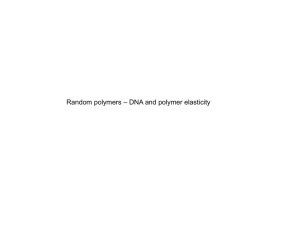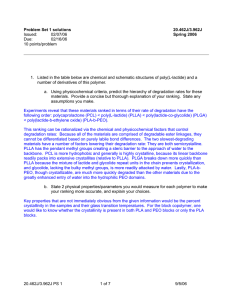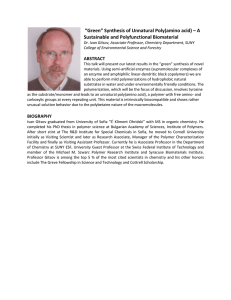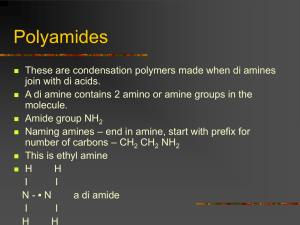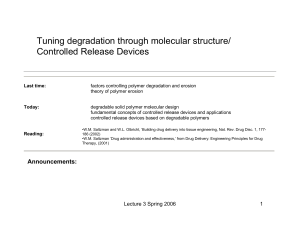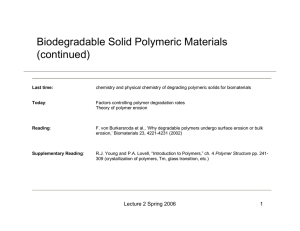Problem Set 1 20.462J/3.962J
advertisement
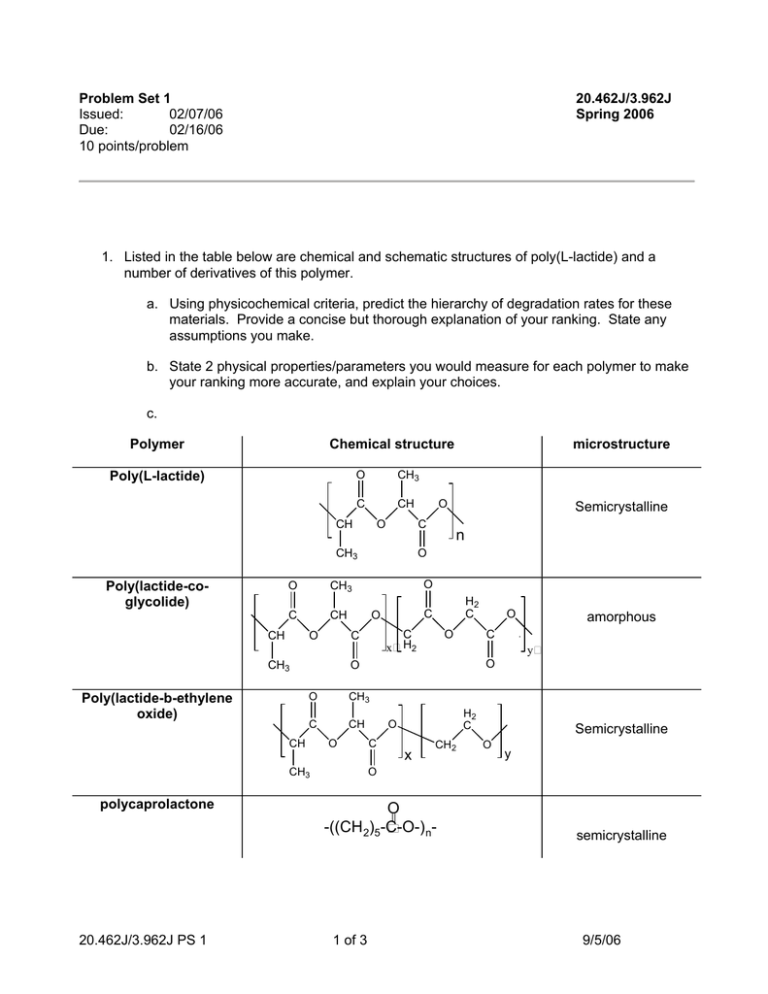
Problem Set 1 Issued: 02/07/06 Due: 02/16/06 10 points/problem 20.462J/3.962J Spring 2006 1. Listed in the table below are chemical and schematic structures of poly(L-lactide) and a number of derivatives of this polymer. a. Using physicochemical criteria, predict the hierarchy of degradation rates for these materials. Provide a concise but thorough explanation of your ranking. State any assumptions you make. b. State 2 physical properties/parameters you would measure for each polymer to make your ranking more accurate, and explain your choices. c. Polymer Chemical structure Poly(L-lactide) O CH3 C CH CH O Poly(lactide-coglycolide) O CH3 C CH CH O n O H2 C C O C x H2 CH3 C CH CH3 amorphous y O O O O C O O CH polycaprolactone Semicrystalline O C CH3 Poly(lactide-b-ethylene oxide) O C CH3 microstructure H2 C O C x CH2 Semicrystalline O y O = O -((CH 2)5-C-O-) n- 20.462J/3.962J PS 1 1 of 3 semicrystalline 9/5/06 2. Given below are data from in vitro degradation experiments on poly(lactide-co-glycolide) and polycaprolactone (C. Pitt and Z.-W. Gu, J. Contr. Rel. 4, 283-292 (1987)). Solid samples of each polymer (films 2 cm x 2 cm x 1.0 mm) were prepared; samples were incubated for the defined time periods in phosphate buffered saline pH 7.4. After incubation, each sample was washed with pure water, dried under vacuum, and then the average molecular weight of polymer chains in the samples was measured using gel permeation chromatography. a. Based on the data and experimental details, are these polymers exhibiting bulk or surface erosion? b. Using the given data, calculate the effective rate constant for degradation of each polymer. For each polymer, explain whether the data allows you to distinguish whether the degradation is autocatalytic or non-autocatalyzed. c. What is the maximum useful lifetime you would expect for an implanted device fabricated from each of these polymers given your calculations above, assuming that degradation kinetics of these materials are similar in vivo? (Explain your answer). 20.462J/3.962J PS 1 time (hr) PLGA MW (g/mole) PCL MW (g/mole) 0 24600 61800 500 9600 58700 1000 3400 56100 1500 1600 53500 2000 900 51000 2 of 3 9/5/06 3. Göpferich erosion theory: a. Does Göpferich erosion theory account for autocatalysis during polymer degradation/erosion? b. Your research team at a startup company is working on using biodegradable polymers as scaffolds to promote bone regeneration. You have found that a polyanhydride, poly(carboxyphenoxyhexane) (PCH, structure shown below), has good mechanical properties for this application. However, porous bone scaffolds with mean strut dimensions of 250 µm (as illustrated below) degrade by surface erosion and this causes the scaffold to loosen in its position when implanted at a bone defect. Show that the erosion number calculated for this situation agrees with the experimental observation. c. You’d like to engineer your PCH scaffolds to degrade by bulk erosion. Your colleagues suggest that the problem could be overcome by blending PCH with poly(ethylene glycol), which will phase separate and raise the average diffusion constant of water in the matrix to a value one tenth that of water’s natural selfdiffusion coefficient (water diffusion in water). Will this drive the scaffold to erode by a bulk mechanism? (Defend your answer with a calculation). An alternative proposal is to make the struts of the scaffold thinner. Which route would you pick an why? PCH structure Porous PCH scaffold O C=O O=C n 6 250 µm wide-struts Data for PCH: ρ = 1.05 g/cm3 degradation rate constant k = 1.9 s-1 Figure by MIT OCW. DH2O (diffusion coefficient of water in PCH) = 1x10−8 cm2 s-1 20.462J/3.962J PS 1 3 of 3 9/5/06
